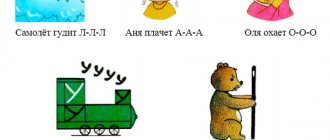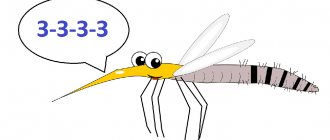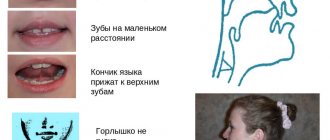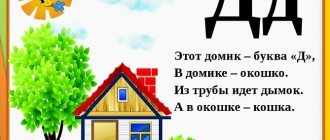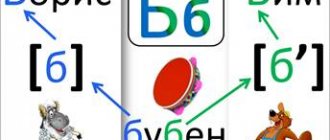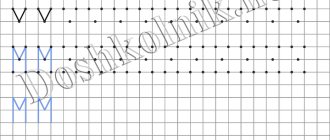In speech therapy there is the concept of sound automation. In relation to the formation or correction of a child’s speech skills, this is the development of a complex ability to recognize a sound by ear, recognize it in a word, and also pronounce it freely and correctly in various positions.
It’s good when children’s speech development is monitored by professionals. But solving some problems is within the capabilities of parents armed with knowledge.
The lesson notes on audio automation B can be viewed here.
Summary of educational activities for speech development “Sounds [G], [G']; Letter "G"
Articulation of the sound G
Mastering any speech sound is a gradual process. First, isolated pronunciation is developed, it is clarified and stated. And parents are unlikely to be able to help their child if they themselves do not know how a particular sound is formed.
IMPORTANT! Age-related difficulties with the pronunciation of the posterior palatal (rear lingual) consonant sounds G, K and X are in many ways natural. Even just activating the root of the tongue and coordinating its interaction with the back of the palate can be difficult for a baby. Indeed, outside of speech activity, muscle motility in this part of the oral cavity is mainly of a reflex nature and does not require conscious control.
Articulation is the control of the conditions necessary to pronounce a sound. In the process of automation, stable patterns of interaction between parts of the speech apparatus are developed. This relieves the speaker of the need to constantly monitor the articulation process; it is actually programmed.
In the “Broca's area” of the cerebral cortex, commands are given, after which the necessary conditions for pronouncing a specific sound in a specific position are reproduced automatically.
This concerns not only the “obstacles” in the mouth and the general configuration of the oral cavity, but also the characteristics of the air stream, as well as the condition of the vocal cords, which are used to form vowels and voiced consonants.
Now specifically about the sound G. The previous stage in its production should be mastering the sound K, since from the point of view of articulation they are very close:
- lips and teeth are open and in a neutral position;
- the tip of the tongue lies and does not touch the lower incisors;
- the back of the tongue meets the palate;
- the lateral edges of the tongue touch the upper molars;
- The soft palate is raised and pressed against the back wall of the nasopharynx.
The difference lies in the participation of the voice and the characteristics of exhalation. In addition to the above conditions, when pronouncing the sound G:
- the ligaments close and vibrate;
- the air stream does not have such an impulsive and explosive character.
Features of articulation G' (soft sound):
- the back of the tongue is sharply curved in the middle part and touches the hard palate;
- the tip of the tongue approaches the lower incisors;
- the corners of the mouth are pulled back;
- lips press against incisors.
IMPORTANT! Articulation of the G sound in conjunction with other subsequent sounds is a little more difficult than its own sound, but isolated. Any sound following G determines what shape the lips take, and vowels additionally affect the distance between the incisors.
Possible deviations and disorders for which it is strongly recommended to consult a speech therapist:
- noticeable distortion of the G sound or its absence (gammatism);
- replacing the sound G with another consonant - K, D and the corresponding soft ones (paragammatism).
The causes of gammatism and paragammatism can be both insufficient development of the muscles of the tongue and congenital structural features of the palate. Sometimes behind these speech defects there are pathologies of phonemic (sound recognition) and physical hearing or a violation of the innervation of the language. Thus, these speech defects cannot be left unattended. Along with a speech therapist, the problem may fall within the competence of a pediatrician or neurologist, as well as other medical specialists.
Sound [s]
Preparatory stage
Lesson 1
Breathing exercises
"Harmonic". I. p. - stand straight, lower your arms. Place your palms on your tummy and take a deep breath through your nose. Hold your breath for 1-2 seconds. Exhale through your mouth.
Development of exhalation force. Developing the correct direction of the air stream along the midline of the tongue
"Cold wind". Having drawn air into your lungs, blow forcefully through your lips extended forward with a tube. Bring the back of your hand to your mouth. You should feel a sharp, beating cold stream.
Exercises for lips and facial muscles
Game exercises
"Smile". “We are glad to meet a friend.” Stretch your lips in a smile to the limit and hold them in a tense position for some time. The teeth are closed. Repeat 3-4 times.
"Cranky monkeys." Movements with closed lips to the right and left. (If you have difficulty, help with your index fingers.)
Exercises to flatten and strengthen the lateral edges of the tongue
"Track". Place your wide, spread tongue on your lower lip and hold it in this position for a count of 5.
“The tongue is looking for a crack in the fence.” Extending the spread tongue between the teeth and biting it. (Teeth marks should remain on the tongue.)
“The tongue is sleeping on the crib.” Descent of the back of the tongue. Press the tip of the tongue against the lower incisors and lower the back.
Note. In case of difficulty, ask the children to cough and yawn, while the soft palate involuntarily rises and the root of the tongue falls. You can interest children by offering to meet or say hello to the little tongue.
Development of phonemic awareness
Isolation of the sound [s] against the background of syllables and words among sounds that are distant in acoustic and articulatory characteristics.
Game "Catch the Sound". The child should clap his hands when he hears the sound [s]. First, the teacher pronounces the sounds [l], [s], [r] [s], [l], [m], [b], [s], then the syllables la, so, ro, su, pa, su, sy , ba.
If a child identifies a sound from a sound or syllabic series, the words
poppy, cheese, souk, shelf, son, bun, lamp, catfish are given.
Development of the voice and switchability of the organs of the articulatory apparatus
Pronunciation of vowel sounds with changes in the strength and pitch of the voice.
“Let’s sing a lullaby to the doll”: a-a-a-a-a-a-a-a-a.
“Toothache”: o-o-o
"Steamboat whistle": ooh-ooh.
Lesson 2
Breathing exercises
Development of exhalation force
Blowing through a tube. Blowing soap bubbles. Comparison of expiratory duration. Pronouncing the sound [f] (long exhalation), pronouncing the sound [t] (short exhalation).
Developing the correct direction of the air stream along the midline of the tongue
Blow a paper snowflake off your palm. Whose snowflake will fly farther?
Exercises for lips and facial muscles
"We are having fun". "Smile". The lips are in a smile, the teeth are brought together to 2 mm.
"Sponges are swinging on a swing." Teeth and lips are clenched. Alternately lift the corners of your mouth with the help of your fingers.
“Sleep, little peephole, sleep, other one. The right eye sleeps - wakes up. The left eye sleeps and wakes up.” Alternately opening and closing the eyes.
Tongue exercises
"The tongue is tanning." Place your tongue on the bottom of your mouth. “The tongue dived to the bottom of the river.” "Let's see where the little tongue lives." Lowering the tongue to the bottom of the mouth.
“The tongue fits through the crack of the door.” Biting the tongue with teeth from tip to middle and vice versa.
"Monkey Teasing" Place your wide tongue on your lower lip and pronounce the syllables five-five-five-five-five.
Development of the voice and switchability of the organs of the articulatory apparatus
"Conversation between the dogs Barbosa and Pushka." Pronouncing syllable combinations pa-ba, py-by, po-bo, pu-bu
whisper, quietly and loudly.
Development of phonemic awareness
Isolating the sound [s] among sounds that are similar in acoustic and articulatory characteristics. Sounds: [s], [z], [s], [sh], [ts], [s]. Syllables: sa, for, so, sha, tso, su, zy, sy.
The words
dog, bunny, sun, fur coat, boots, garden
, etc. The child raises his hand or claps his hands if he hears the sound [s].
Lesson 3
Breathing exercises Developing exhalation power
"Put out the candle." Developing an intense intermittent exhalation while pronouncing fuuuuu.
Developing the correct direction of the air stream along the midline of the tongue
"The storm is howling." Bring a bottle with a narrow neck to your lower lip and blow. If noise appears at the same time, it means that the air stream is directed correctly.
Exercises for lips and facial muscles
“The monkey is smiling, and the baby elephant is ready to drink some water.”
Lips in a smile (hold for a count of 5-6). Alternating positions - lips in a smile and “tube”.
“My teeth hurt on the right side. The teeth on the left side hurt.” Alternately raising the corners of the mouth while simultaneously closing the corresponding eye.
Tongue exercises
"Raindrops are pattering on the roof." Bite your wide tongue with your teeth and pronounce the syllables ta-ta-ta-ta-ta-ta.
"Shovel". Place a wide tongue on the lower lip so that the side edges of the tongue touch the corners of the mouth. The language is calm, not tense. If the tongue does not relax, suggest squeezing your lips tightly, then stretch them into a smile and push your tongue between them.
Exercises to develop the ability to form a bow with the lateral edges of the tongue with the upper molars
“The baby learns to pronounce the sound [i].” Place the tip of your tongue behind your lower teeth and pronounce the sound [i]. Make sure that the dimple in the tongue is exactly in the middle.
"Donkey's Song" Pronouncing the sound combination ia.
"Boat". Stick your tongue out of your mouth and fold it into a boat (“groove”). If the exercise does not work, you can place a thin stick or probe on the middle part of the tongue.
"Fungus". I will collect different mushrooms in a basket - russula, moss mushroom, etc. Sucking the tongue to the roof of the mouth. (Recommended for use when correcting lateral sigmatism.)
Development of switchability of the organs of the articulatory apparatus and coordinated work of the lips and tongue
Pronouncing the vowels i-yu, yu-ya, i-e, e-ya; i-i-e; and-i-e-yu.
Development of phonemic awareness
Isolating the sound [s] from words. Find toys whose names contain the sound [s], from a number of others ( owl, fox, bear, dog, baby elephant, car, giraffe, donkey
)
.
Determining the position of the sound [s] in the words owl, baby elephant, forest, nose.
Lesson 4
Breathing exercises
Development of exhalation force
Developing the correct direction of the air stream along the center line
“The sled went down the hill.” Smile, lower the tip of your tongue behind your lower teeth, and raise your back up. Exhale.
Developing a long, strong exhalation while pronouncing the sound combinations iffffff, iffffff for a long time.
Lip exercises
Lips in a smile (count to 10).
"The boat rocks on the waves." Alternately lifting the corners of the mouth up (with and without the help of hands).
Tongue exercises
“The tongue is sick and lies in bed.” Open your mouth wide and cough (the tongue involuntarily drops to the bottom of the mouth). Place the tongue in a “path” on the bottom of the mouth so that a small tongue appears. (Hold in this position for as long as possible.)
"Teasers." Place your wide tongue on your lower lip and say: bya-bya-bya-bya-bya, five-five-five-five-five-five
(with a change in intonation).
The tongue is “grooved” inside the mouth.
Note. If the exercise does not work, use a bottle with a narrow neck. When you blow into a bubble, a round gap involuntarily appears in your tongue.
"Funny Clowns" Arching of the back of the tongue upward while the tip rests on the gums of the lower incisors. Pronouncing the sound combination i-hee-hee.
Development of switchability of the organs of the articulatory apparatus
“The tongue swings on a swing.” Pronouncing the syllables ya-la, ya-la, ya-la,
gradually increasing their number in one exhalation.
Development of phonemic awareness
Distinguishing words that sound similar: bear
-
bowl, helmet
-
porridge, cheese
-
ball, salt
-
play naughty
(based on pictures).
Finding pictures with the sound [s] in their names on the topics “Vegetables” and “Fruits”.
Lesson 5
Development of exhalation force
Developing the correct direction of the air stream along the midline of the tongue. "The wind shakes the leaf." Lips in a smile, teeth open. Blowing on a protruding tongue lying on the lower lip.
Lip exercises
“The hippopotamus has his mouth open, the hippopotamus is asking for rolls.” Smile. On the count of “one,” clench your lips tightly, and on the count of “two,” open your mouth wide.
Tongue exercises
Arching of the back of the tongue upward while the tip rests on the gums of the lower incisors. Pronounce i, hee, ee.
Raising and lowering the middle part of the tongue (the back of the tongue with the tip of the tongue lowered at the lower gums.
"Boat". Raise the side edges of the tongue until you have a depression in the middle of the tongue.
"Cheerful children." The starting position is the same. Pronounce the sound combinations ihi-hi, ihi-hi, ihi-hi.
Development of switchability of the organs of the articulatory apparatus and development of coordinated work of the lips and tongue
"Alien Conversation" Pronouncing the syllables ti-ti-ti, cha-cha-cha, te-te-te
(with a change in stress and intonation).
Development of phonemic awareness and simple types of phonemic analysis
— Is there a sound [s] in the words cabbage, beets, radishes, beans, lettuce, garlic?
?
- Find vegetables whose names contain the sound [s]. Where is the sound [s] heard in the word salad
?
In the word garlic
?
In the word cabbage
?
Development of logical thinking
Game "Fifth Odd". Cabbage, beets, potatoes, radishes, apricots.
Set aside the extra picture.
Lesson 6
Development of exhalation force
Developing the correct direction of the air stream along the midline of the tongue
Smile. Lower the tip of your tongue behind your lower teeth, raise your back in a “mound”, and exhale.
Lip exercises
Raising and lowering of the upper lip exposing the upper teeth.
Alternate raising and lowering of the corners of the mouth.
Tongue exercises
Keep your tongue motionless with the “groove” on the outside of the mouth, and then open your lips widely, then touch the “groove” with them.
Game “I am not me.” The speech therapist pronounces phrases, and the children answer: “And I” or “Not me.” For example, a speech therapist says: “I love chocolate.” And the children answer: “And I, and I, and I.” “I love to chew a cup.” Children: “Not me, not me, not me.”
Development of switchability of the organs of the articulatory apparatus and development of coordinated work of the lips and tongue
Pronouncing syllable combinations pti-pti-pti, pty-pty-pty; petit-pt, petit-pt; pt-pt-pt-pt-pt.
Development of phonemic awareness
“Pick it up and name it.” Place pictures in two piles depicting objects whose names contain the sounds [s] and [w].
Determine the position of the sound [s] in the words sled, boots, owl, bus.
Sound setting [s]
The position of the organs of the articulatory apparatus when pronouncing the sound correctly [s]
The teeth are brought together and are at a distance of 1 mm. The lips are stretched as if smiling. The tongue rests on the lower incisors; a “groove” is formed in the middle of the tongue, along which a stream of exhaled air flows. The sound [s] is dull, pronounced without the participation of the voice.
Techniques for sound production [s]
Auditory perception of sound. Creating an auditory image of sound
Gaming techniques. "Whistles." "Snowstorm".
Formation of a visual image of sound
Showing the articulatory position of a sound on a dummy or articulation diagram. Articulation profile display.
Formation of a kinesthetic image of sound
(feeling the position of the organs of articulation)
Showing the position of the organs of articulation using the fingers. Lower the clenched fingers of the right hand (imitation of the tongue) to the base of the fingers of the left hand (as if they were the lower teeth). Description of the position of the organs of articulation.
Open your mouth. Lower the tip of the tongue towards the lower incisors so that a gap forms in the middle of the tongue. Exhale forcefully and evenly. The sound should be [s].
Note. If a “groove” does not form along the midline of the child’s tongue, place a stick along the tongue. Close your teeth as far as the stick allows and pronounce the sound [s]. Do the same exercise with slowly removing the stick from your mouth to your teeth and out, then repeat several times without using the stick.
Correction of hissing sigmatism according to M.E. Khvatsev (1959)
1. Raising and lowering the middle part of the back of the tongue with the tip of the tongue lowered at the lower gums.
2. Blowing on the tongue when it is in a low position.
3. The tongue is set with a deep “groove” and the sound [s] is pronounced. Then gradually the depth of the “groove” decreases.
4. The sound [s] is pronounced.
Sound setting [s] according to R.E. Levina (1965)
1. Interdental pronunciation of the sound [s]. Consolidation in syllables, words, and then transition to normal articulation.
2. The child pronounces the sound [r] in a drawn-out manner, and then, doing the same, push the tongue as far forward as possible, it is necessary to rest its tip against the lower teeth.
3. Reliance on the sound [x]. Whisper the sound combination ihi,
and then repeat it with clenched teeth.
4. Pronouncing the combination e
with tension.
Correction of labiodental sigmatism
Show that when pronouncing the sound [s], the lip should not come into contact with the upper incisors or come close to them.
Alternating movements of the lips with a sequential change in their closing and opening, associated with baring of the teeth and exposure of the lower incisors.
If necessary, mechanical assistance is used in the form of pressing the lower lip downwards with a spatula. Long pronunciation of [s], and then syllables and words that begin with it.
Correction of interdental sigmatism
Clench your teeth and, without unclenching them, pronounce [s] in a drawn-out manner. (At first, the sound is pronounced with clenched teeth.)
Pronouncing syllables and words with clenched teeth. Gradually they move to normal pronunciation of the phoneme.
Correction of dental sigmatism
Demonstration of correct phoneme articulation. Using a profile picture. Reliance on kinesthetic sensations (feel a cold stream on the back of your hand when correctly pronouncing the sound [s]).
Articulation exercises
Inserting a flat tongue between the teeth.
Sticking out the tongue in a “groove” manner with the mouth open.
Arching of the back of the tongue upward while the tip of the tongue rests on the gums of the lower incisors.
Use of mechanical assistance.
Correction of hissing sigmatism
Distinguishing between the correct and incorrect sound of the sound [s] (whistle - hiss).
Showing in front of a mirror the differences between correct and defective articulation.
Additionally, use kinesthetic sensations, depicting articulation with the hands.
Having achieved correct articulation, turn on the exhalation, let you feel the cold stream of exhaled air.
You can temporarily use interdental articulation of the sound [s]. In the future, move on to normal pronunciation with clenched teeth, as is done when correcting interdental sigmatism.
Correction of lateral sigmatism
Achieve the formation of a “groove” along the midline of the tongue.
Use the sound [t] as a base. Pronounce [t] with some aspiration. The presence of aspiration is controlled by feeling a stream of air on the hand.
At the next stage of work, the child is asked to lower the tip of the tongue behind the lower incisors. Clench your teeth and pronounce a sound close to [ts], which contains the sounds [t] and [s].
Gradually, during the exercises, the sound [s] lengthens and then separates. After which you can explain to the child that this is the correctly pronounced sound [s].
Use of mechanical assistance.
The child is asked to pronounce the sound [f], pushing the tongue forward as much as possible and resting its tip on the lower teeth. The noise characteristic of the sound [w] should be accompanied by a whistling noise.
Rely on the sound [x].
Whisper the combination ihi,
and then pronounce the same sound combination with clenched teeth. In this case, a sound close to [s'] is heard.
As a result of the exercises, the sound is fixed, and then you can pay attention to the difference in the sound of the sounds [s] and [s'].
Correction of nasal sigmatism
Work out the correct direction of the air stream, closing the passage into the nasal cavity by raising the palate. Developing correct articulation of the tongue.
Correction of sound replacement [s] to [t], [d]
1. Inserting a flat tongue between the teeth.
2. “Grove” with the mouth open.
3. Bending the back of the tongue upward while the tip rests on the gums of the lower incisors.
Correction of lateral sigmatism according to E.Ya. Sizova (1992)
Massage of facial muscles and lips
The massage is performed with hypercorrection of the affected side:
- patting the smoothed nasolabial fold;
- circular movements at the junction of the masticatory muscles;
- stroking lips;
- slight tingling of closed lips (usually on the affected side);
- circular stroking movements in the corners of the mouth (more on the side of the smoothed nasolabial fold);
- slight tingling of the lowered corner of the mouth;
- pinching of the edge of the lower jaw (more on the affected side).
Tongue massage
- light stroking of the tongue;
- tapping the tongue with a spatula or fingers;
- very light tapping on the affected side edge of the tongue.
Articulation gymnastics
Exercises for lips and facial muscles
Teeth and lips are clenched. Alternately raise the corners of your mouth. If the corner of the mouth does not rise, help with your fingers. At the same time, keep the other corner of your mouth calm. Lift the corner of the mouth affected by paresis two or three times, and the healthy one – once.
Tongue exercises
1. Smile, place your tongue on your lower lip, then move your tongue to the right side and bite the left edge of your tongue with your teeth. Return to starting position.
2. Smile, place your tongue on your lower lip, slightly move your tongue to the left and bite the right edge of your tongue with your teeth. Return to starting position.
3. Smile, put your tongue on your lower lip, move your tongue to the right side and slide your teeth along your tongue.
4. Smile, place your tongue on your lower lip, move your tongue to the left side and slide your teeth along your tongue.
5. Biting the side edges of the tongue.
For the affected side, the number of exercises is doubled.
Consolidation of the auditory image of sound
Teaching the correct pronunciation of the sound [s] in isolated sound
Game exercises
“A cold wind is blowing”, “Song of water flowing from a tap”, “Water flows over pebbles”, “The wind whistles in a pipe”, “Air comes out of a wheel”, “Punctured tire”, “Pump”, “Let’s pump air into the wheel” ", "Punctured ball", "Steam comes out of the pan", "Kettle with a whistle".
- Automation of the sound [Сь] in forward and backward syllables
- Sound automation [Сь] in isolated form
- Automation of sound [C] in isolated form
- Automation of the sound [С] in reverse syllables
- Automation of the sound [С] in straight syllables
- Speech material for automating the sound [С] in phrases and sentences
- Automation of sound [С] in words
- Summary of an individual speech therapy lesson Topic: “Automation of the sound [S] in syllables, words, sentences”
- Summary of individual lessons. Topic: “Sound Automation [R]”
- Automation of sound [Ш]
- Sound automation [H]
- Sound automation [F]
- Sound automation [Ш]
- Summary of individual speech therapy sessions. Topic: “Automation of the sound [L] in syllables, words, sentences”
Automation of the G sound in syllables
In this exercise, the child is asked to listen, remember and pronounce various syllables and their sequential combinations. The transition from simple to complex is observed.
Combination of G with vowel sounds:
- ha-ha;
- ho-ho;
- goo-goo;
- ga-go-gu;
- uh-huh-uh-huh.
Syllables involving other consonants:
- gwa-gwo-gwu;
- gla-glo-gloo;
- sga-sgo-sgu;
- rga-rgo-rgu.
For G' (soft sound):
- ge-ge;
- gi-gi;
- gli-gli-gli;
- gree-gree-grie.
Methods and techniques for producing sounds [С], [Сь], [З], [Зь], [Ц]
In cases of dental sigmatism, it is sufficient to lower the tip of the tongue to the lower teeth with mechanical assistance and thus obtain a gap instead of a bow.
In labial-dental pronunciation, it is necessary to inhibit the participation of the lips, for which preparatory articulation exercises are carried out. Or slow down the movement of your lips with your finger.
In other cases, the child is asked to smile, pulling the corners of the mouth so that the teeth are visible, and blow on the tip of the tongue to produce a whistling sound.
The child is asked to pronounce the syllable ta repeatedly, the speech therapist inserts probe No. 2 or a ball probe between the alveoli and the tip of the tongue (as well as the front part of the back of the tongue) and presses down lightly.
With interdental sigmatism, you need to pronounce the syllable [sa] with clenched teeth at the beginning of its pronunciation or slightly lengthen the pronunciation of the consonant, and lower the jaw on the vowel a.
For lateral sigmatism, a two-stage placement technique is used: they cause interdental pronunciation to get rid of the squelching noise, and then move the tongue to the interdental position.
In some cases, with isolated nasal sigmatism, the sound is placed from the sound [F]. By pushing the tongue between the teeth and moving the lips away with mechanical assistance.
Pronunciation of the combination [ee] or [th] with tension prepares the desired form of the tongue and produces a concentrated air stream.
Similar to the sound [x]. Lips in a smile, teeth in the form of a correct bite (slightly closed). Ask the child to pronounce the sound [x] “into the teeth” and feel the cool air stream with his palm.
The child is asked to pronounce the sound [T] with a strong forced exhalation. The resulting noisy sound (close to [Ts]) should be stretched out as long as possible. It is necessary to monitor the position of the lips in a smile and control the force of the air stream with the palm of your hand.
An equivalent method of staging from the sound [ts]. By lengthening and adjusting the strength of the sound pronunciation, a clear [s] is achieved: TSSSSssssssss.
A very rare technique of staging while inhaling . Place a wide tongue at the bottom of the mouth so that it is in contact along the entire perimeter with the lower teeth. Stretch your lips into a smile, teeth slightly closed in the form of a correct bite. In this position, after exhaling (shoulders should be lowered), the child should “suck” very little air into himself, so little that it hits the very tip of the tongue. Next, “drive” a stream of air into and out of the mouth. At first, the exercise is performed at a fast pace, then, if the sound is clear, slow down the pace.
From the sound [sh] by imitation or mechanically, slowly moving the tongue forward to the upper teeth, then down. The teeth should be closed.
The sound [Sj] can be placed from [S] in combination [isi] with the highest possible sound [ii] at a fast tempo.
Similar to the production of [s] from the sound [Хь].
The sound [З] (зь) is placed in the same way as [s] (сь), but with the voice connected. In cases where the sound [z] still turns out to be dull, it is pronounced between two consonants - [mzm]. Draw out the sound [m] as long as possible, and pronounce the sound [z] (s) quickly.
The sound [Ts] is made from a combination of [t] and [s] or from [t] at a fast pace with a forced exhalation on [t]. However, the sound in the reverse syllable is better - [ats].
[Ts] from the sound [h] by imitation, stretching your lips as much as possible in a smile.
Automation of the G sound at the beginning of words
Listen and repeat clearly, highlighting G:
- gas, lawn, newspaper, din, hammock, gamut, smoky, accordion, harbor, tie, clearance;
- goal, hunger, voice, dove, head, rut, race, hounds, racer, year, anniversary, gop, hopak, grief, hill, city, pride, gorilla, dialect, beef, guest, gift;
- hum, goulash, goose, caterpillar, herd, lips, sponge, beep, threshing floor, thicket.
For G' (soft sound):
- Gene, genius, Hera, geranium, coat of arms, herbarium, Huck, gel;
- guide, hydrant, weight, anthem, gymnast, hypnosis, guitar, giant, hyena.
IMPORTANT! It is necessary to explain to the child any word he does not understand, thereby expanding his vocabulary and making the “training” process meaningful. What the baby understands is better remembered by him.
Consolidating the sound G in a child’s speech
Most speech therapists and speech pathologists consider the concepts of “consolidation” and “automation” as identical.
Sometimes sound consolidation is understood as the step-by-step work process of comprehensive development of a phonetic unit, and automation is the achieved complex result.
The bottom line is that consolidation (automation) means going through a sequential set of various speech exercises that help the child reliably learn a relatively fragile spoken sound.
Each new phonetic image or ideomotor (articulatory) template is especially fragile if the clarification and production of the correct sound was preceded by getting rid of its defective version.
An important aspect of consolidating a speech sound is the need to “test” its use in various arbitrary phrases and sentences, as is what happens in real speech. Below are examples of such exercises.
Setting sounds [Р], [Рь]
A set of exercises for the sounds Р, Рь:
- "needle",
- "fast snake"
- "turkey poults"
- "bucket"
- "horse"
- "painter",
- "woodpecker",
- "steps"
- "drummer",
- "balalaika".
Methods and techniques for producing sounds [P], [Pb].
By imitation.
The child is asked to perform the “mushroom” exercise. At the moment of suction, ask to blow forcefully on the tip of the tongue. A voice is added to the resulting dull vibration.
When the upper elevation of the tongue is set, the child is asked to pronounce the combinations: jzhzh, zhzhzh, or d-d-d-d. At this point, use a spatula, ball probe or clean finger to make quick movements from side to side along the bottom of the tongue closer to the tip.
For spasticity of the tongue root, this technique is used while lying down.
In a similar way, you can call [P] from [Z] the upper rise. The child is asked to hold his tongue at the base of the upper teeth and pull out the sound [З] for a long time. During its pronunciation, the tip of the tongue is in a more tense state and the air stream is more forced. The resulting sound is not clear, but rather noisy. The resulting sound mechanically causes a trembling [P].
When pronouncing [P] in the throat, the production takes place in 2 stages.
Setting up a single-strike [P] from the sound [Zh]. When pronounced in a drawn-out manner, without rounding the lips, moving the tongue slightly forward, towards the gums of the upper teeth. In this case, the sound is pronounced with significant air pressure and a minimal gap between the front edge of the tongue and the gums. Then the placement is carried out using a probe as in other cases.
The most common technique is the production of [D], repeated on one exhalation, followed by a more forced pronunciation of the latter.
When pronouncing the combination [tdtdtdtd] repeatedly, with the mouth slightly open and when the tongue is closed with the gums, vibration occurs. However, this method is not suitable for correcting velar or velar [P].
When the mouth is closed with teeth tightly clenched, sometimes in combination [tr] a voiceless [r] (prodental) is heard. You can make a sound from it if, while pronouncing this combination, you gradually open your mouth, pushing a spatula between your teeth.
To maintain the upper elevation of the tongue, use the “turkey poult” exercise. When quickly pronouncing the combination [blblbl], the lower lip is first lowered (the tongue moves along the upper), then the movements are transferred to the upper incisors, and then to the alveoli. This sound turns out to be slightly burry. To eliminate this defect, you should ask the child to fixate a strong exhalation on the sound d.
If the child does not maintain the upper position of the tongue, and the sound comes out dull and not booming, you can ask the child to “extend” the sound – drn – drn (“start the car”).
Automation of the G sound in pure tongues
Pure sayings are easy-to-remember comic similarities to nursery rhymes or counting rhymes that are well suited for the role of exercises. Pure tongues begin with the repetition of several syllables, where attention is focused on the sound being reinforced.
Composing phrases yourself is a good way for parents to creatively approach the development of their child’s speech. It's better if they make at least a little sense. Here are some examples.
- Ha-ha-ga, ha-ha-ha, - the geese go to the meadows.
- Oh-ho-ho, oh-ho-ho! - There is nothing in the cave.
- Goo-goo-goo, goo-goo-goo, - the owl is hiding in a haystack.
- E-ge-ge, e-ge-ge! - we are running along the rainbow.
- Gi-gi-gi, gi-gi-gi, they call us for pies.
Finally
G is just one of the speech sounds. And it’s far from the only one that causes difficulties for young children. When working with a child, we must remember that an adult’s speech must be clearly intonated, and the external features of articulation must be clearly distinguishable.
You should not repeat defective scale patterns after your child. It is useful to show examples of correct speech several times. It is recommended to stimulate the child’s speech with questions.
Related posts:
- Rhoticism in speech - complete information Rhotacism (problem with the sound [P]) is the most common disorder in children...
- The sound “Zh” - from production to automation Automation of the sound “Zh” begins with identifying the reasons that interfere with the correct sound pronunciation...
- A child does not know how to say R - we’ll show you how to teach it. To teach a child to pronounce the letter R, you need to regularly perform special...
- Signs of glasnost in the Russian language All speech sounds are divided into vowels and consonants, between them...
Articulation gymnastics in simple exercises
In addition to special exercises for a specific sound, which we will consider below, articulatory gymnastics can be called anything that develops the mobility of the facial muscles and speech organs. A child can play around and be naughty, make funny and scary faces, stick out his tongue, open his mouth wide and do similar funny things with great benefit for himself. Use this as a warm-up before class, and at the same time set a playful mood for the work process.
- Smile from ear to ear. We alternately smile as broadly as possible and return to the starting position. Lips closed.
- Fence. In a smile, show all the teeth at once (both lower and upper). Hold the position for 5 seconds.
- Up down. The child smiles and opens his mouth wide. The tongue alternately rises up behind the alveoli and falls down behind the lower teeth. It is important that during the exercise only the tongue moves, the lower jaw and lips should remain in place.
- We brush our teeth. The child smiles, opens his mouth and makes circular movements with his tongue along the outside of the teeth in both directions.
- Slide. The child smiles and opens his mouth wide. The tip of the tongue is behind the lower incisors, the back of the tongue is raised as high as possible. Hold this position for 10 seconds.
For correct articulation of the autonomous sound [C], we stretch our lips in a smile with our teeth closed. The tip of the tongue should rest against the lower teeth. For proper sound production, the air flow must pass exactly in the middle of the tongue. Be sure to show your child articulation by example. If he has difficulty keeping his tongue down, use a speech therapy spatula to apply light pressure on the tongue.
